
It only stands to reason. I am the son of Harry L. Munger, a man prone to misadventure when it comes to motor vehicles and long-distance travel. I mean, there are any number of stories about Harry and boat and snowmobile trailers gone awry I could call upon to make my point. But I won’t. Just accept me at my word when I tell you that I share my father’s proclivity for trailer-based disasters.
Last summer, René got it in her head that, since I was retired and she would be retiring shortly, we needed a travel trailer. I was OK with the notion because I envisioned us buying a nice little pop-up we could tow with our Jeep Grand Cherokee and its modest V-6. But that notion was quickly laid to rest when we began searching for something to tow. We ended up with a 33′ behemoth, nicely appointed no doubt, dubbed an “ultra light” by its maker, Forest River-Puma. At 6,400 pounds, it exceeded the towing capacity of the Jeep, necessitating yet another purchase. Loving my Jeep, we ended up buying another Grand Cherokee, this one dubbed an “Overland” edition, with a 5.7 liter Hemi V-8 and a towing capacity of 7,200 pounds. Barely enough to pull the camper but I wasn’t interested in the other options: a pick-up truck or a full-sized SUV.
In addition to being catastrophe prone when it comes to trailers, I’m the world’s worst when it comes to backing them up. My boys have stood by, laughing their asses off, any number of times as I’ve tried to back my fishing boat and trailer into the water. Sure, a back-up camera helps but, after trial and error, I’ve found the soundest logic is to simply watch my driver’s side mirror and fix an eye on the launch and the tires, keeping things in line as I back up. I’m no expert but, at least when it comes to backing up a 16′ foot boat and trailer, I’m getting better. That doesn’t mean I’m at all comfortable with the notion of trying to back a 33′ giant house between two other giant houses at a campground.
This is a long-winded way of saying that, when our friends the McVeans invited us to camp with them last summer, I insisted that any spot reserved for us would have to be what’s known as a “pull-through”, meaning you simply pull straight in, unhitch the trailer, and park your car. No backing up required. Nancy McVean ensured me that the spot reserved at the Apostle Islands Campground in Bayfield would be a pull-through. But when we arrived to check in, the owner was very apologetic: “I’m sorry. We only have one of those and it’s taken.” I was pretty sure the Big Ass Camper was going to head home at that point until I gleaned falsehood in what I was being told. Sure enough, I’d been set up. He was pulling my leg.
The new Jeep seemed adequate to haul the Puma to Bayfield and back. We also took a short jaunt, really the maiden voyage (a few weeks before the Bayfield excursion) to the KOA in Hayward. That too went smoothly and Matt and his two sons joined us for an overnight, with Lisa and Ari and my mom stopping in for dinner. Despite the Jeep feeling adequate to pull the Big Ass Camper during those two “trial runs”, trepidation bubbled just beneath the surface. I remained worried that the trailer was too heavy for the Jeep. But winter was on the horizon so I found a place to store the Puma and let the matter be.
This spring, Matt helped me pull the trailer out of storage and set it up in the backyard. Due to COVID, our family tradition of journeying north to the Scott Cabin on Whiteface Lake, a fifty-two year old legacy, didn’t happen. Which meant Matt and me and the boys fished the Cloquet River in my backyard, using the Puma as our basecamp. It was cold over the Fishing Opener and I learned some things. But for the life of me, I couldn’t figure out why, despite turning on the gas hot water heater, the spigots in the kitchen and bathroom delivered only cold water. I figured the water heater was on the fritz so I boiled water on the stove. I had the garden hose hooked up, supplying fresh water to the Puma, so that wasn’t an issue. I’d done a dry run by filling the fresh water tank and turning on the water heater and pump the summer before but, on our two camping outings, we’d hooked up to city water. I didn’t want to carry 50 gallons of fresh water from place to place, increasing the weight of the camper. During those earlier outings, the LP gas water heater worked well. I couldn’t get hot water to come out of the faucet as the boys and Matt and I caught one scrawny catfish over two days of fishing.
“I wonder if there’s a shut-off to the hot water tank that was turned off when the camper was winterized?”
Sure enough, about the time Matt and the grandkids were heading home, I opened up the panel to the heater and found there are not one but two shut-offs. Instant hot water. Lesson learned.
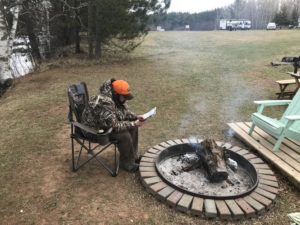
While talking to Ron McVean, a guy who has considerably more mechanical ability than me, I asked if it was possible to add an electric element to the hot water heater. My thought was, if you’re connected to the 30amp service at a campground, it would save on LP gas to be able to use electricity to heat water. “Oh sure. You just add an element to the tank and you’re good to go. They’re all adaptable.”
The next time I was out at the camper, I pulled the exterior cover off the hot water heater. That’s when I discovered the Puma came equipped with both LP and electric elements to heat water. There, in front of my eyes, as big as life, was an “on/off” switch. No need to buy an electric element: It was already installed!
I continued to fret about the size of the trailer knowing that we’d reserved a spot at the Verde Ranch RV Park in Camp Verde, AZ for a week in October. The plan was to drive the trailer to Arizona, stay the week, winterize the camper, and store it at a secure, outdoor lot in nearby Prescott. I’d spent over $700 bucks last winter storing the Puma near home but with the intent of returning to Verde Ranch in the spring, it made little sense to haul the camper to Minnesota, pay to store it, and then haul it back to the Southwest. It turns out the cost of storing the Puma in Prescott is several hundred dollars cheaper than storing it here, though two things are required to pull that off.
First, I’d have to winterize the water lines and water heater to prevent the lines from cracking. Second, because the Puma would be stored outside, I’d need to cover the trailer. I went online, found videos of the easiest and cheapest way to winterize (and checked with friends and Gander to make sure my plan made sense), and also bought a cover. Still, in the back of my mind the thought lingered: “Can the Jeep pull the camper all the way to Arizona?”
I made an appointment to get the Jeep’s oil changed. I also had the techs run the VIN of the Grand Cherokee to get the scoop on what the exact towing capacity of the vehicle is. Sure enough, it turns out the vehicle is fully equipped with the necessary transmission cooling system to tow up to 7,200 pounds. At least I wasn’t going to blow the tranny pulling René’s Big Ass Camper through the mountains.
A couple of short jaunts to Hayward this summer helped shake out more bugs. René found a great place, Lake Chippewa Campground, to stay at. We made two trips, one with just the McVeans and another with a group of their friends, again, using the excursions to learn more about the camping life, our trailer, and the Jeep. Turns out, when fiddling with the electronic display on the dash, I learned I have electronic read-outs for both the oil temp and the tranny temp. Good to know since, despite assurances from Duluth Jeep the car could safely tow the Puma, trepidation remained. Not so much concerning the towing capacity but more concretely, fears that a fierce wind could make the big rig problematic on the open road. Gander had installed an anti-sway and an electric braking system when I bought the rig to keep things safe. But hauling a house with a relatively small SUV, even one with an adequate engine and transmission, seemed daunting given we’d be driving through Minnesota, Iowa, Missouri, Kansas, Oklahoma, Texas, New Mexico, and Arizona: Places where wind would likely be a factor.
Thursday morning. Up at the crack of dawn. The trailer was already hooked to the Jeep. The car was packed. With cups of hot coffee in hand, René and I and Callie, our little Brittany, pulled away from the house and set out for Camp Verde. I’d purchased a rearview camera and installed it on the camper to monitor traffic through an app on my cell phone. My iPhone 7 wouldn’t cooperate and, though I was able to see behind the trailer for a few miles, eventually the images stalled and I turned the thing off. I was relegated to using the mirrors which, thankfully on the Jeep, are big enough and adjustable so that it’s not a problem to see passing traffic.
Our first night in a KOA in St. Louis, MO was uneventful. Though we pulled in long after the office was closed, COVID protocol meant that our reservation paperwork, complete with directions to our campsite, was stuffed in a drawer outside the office. We parked, got things set up, and let Callie out to do her business. The place was clean and quiet, a perfect rest stop after twelve hours of driving.
One of the things you learn in a shake down cruise pulling a Big Ass Camper is to gauge distance. Given the size of the trailer and the limitations of the Jeep in high winds, I kept the speedometer at sixty on the freeways, which meant long days between stops. In addition, somewhere in Kansas, as we headed west towards the Panhandle of Oklahoma and Texas, the very expensive bike rack I’d mounted on the rear bumper of the Puma became an issue. After getting gas in a small, forgetable Kansas town, a guy pulled up alongside us. “Your bike is dragging,” he said, pointing to the rear of the trailer. I stopped, got out, and found the rear wheel of René’s new Aventon electric bike had bounced out of the rack and had been dragged behind us for several miles. Thankfully, other than wearing off some tread, there was no significant damage. I found a piece of rope, tied both bikes to the rack, and we were good to go.
“That could have been a disaster,” I said, reclaiming the driver’s seat. “Stupid-ass bike rack.”
My wife held her tongue.
Our next stop was the KOA in downtown Albuquerque, New Mexico. To get there, we had to endure some arduous travel through desolation. Fourteen hours later, we pulled in after midnight and were greeted by the KOA night man who, with flashlight in hand, led us to our site. The campground is conveniently located between one of the city’s main drags and the freeway, making it less than quiet. Still, Callie had her own fancy little kennel, complete with fake grass and fake fire hydrant.

When I went to pack up for the drive to Flagstaff, a short jaunt necessitated because our Camp Verde reservation didn’t start for another day, I learned that God indeed is great.
“Shit.”
“What’s wrong?”
In connecting the sway bars to the hitch before we left home, I’d either improperly latched a pin securing one of the sway the bars or had completely missed sliding it in place. Either way, we’d driven from Kansas City to New Mexico, through thirty-mile an hour winds and over bouncing highways, with only the weight of the trailer keeping the sway bar from falling off and dragging behind the Jeep.
“I need to go buy a pin for the sway bar,” I said, not revealing to my wife how close we’d come to disaster. A quick stop at the office and I learned that Rocky Mountain RV was just down the street. We drove to the store. I bought some treatment for the black water (sewage) tank and three new pins for the sway bars. I put one of the pins in the hitch and the other two in my tool box. “Not gonna let that happen again,” I muttered.
The quick dash to Flagstaff turned into a crawl. A traffic accident meant that all four lanes, two east and two west, were shut down. The five hour trip took eight. We found the Flagstaff KOA, claimed our reservation from the after-hours box, set up, and spent a nearly incident-free night in a quiet, peaceful setting beneath mountains and pines.
I said nearly incident-free because, when I woke up in the night to let Callie out (she sleeps in a kennel in the trailer), as we stepped outside a skunk skittered out from under the Puma. I kept Callie in close on the leash until the critter vanished but visions of my last encounter with a skunk, where Leala-Callie’s predecessor-was sprayed in the face while pheasant hunting loomed large. Thankfully, the New Mexican skunk didn’t fire and all was right with the world.
Verde Ranch RV is a short drive down the mountains from Flagstaff. What a lovely spot! Because it’s only seven months’ old, the sites, pool, laundry, and other facilities are immaculate. In addition, as I discovered the next morning while walking Callie, the campground sits on the Verde River, which unlike many Arizona watersheds, has water flowing in it year-round.
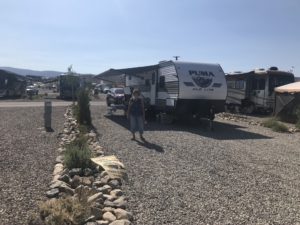
The only disquieting thing about our time at the resort were huge, super-expensive motor homes flying Trump flags. There was only one Biden flag. I made it a point to stop in, mask in place, to thank the couple flying Uncle Joe’s colors.
“You made my day,” I said as an older couple sat in their matching lawn chairs sipping adult beverages.
“Thanks. You’d be surprised at how many folks stop by to say that.”
I should clarify a point. The Grand Cherokee pulled the Puma, all 6,400 pounds and 33 feet of it, just fine. At times, the wind was an issue but, all in all, the Jeep did its job. That said, I enjoyed camping in Hayward and Bayfield and my backyard because the Puma wasn’t outclassed, even by the motorhomes driven by the McVean’s and their friends. But at Verde Ranch? Our camper was one of the more modest units amongst the half-million dollar plus motorhomes surrounding us, Trump flags or not.


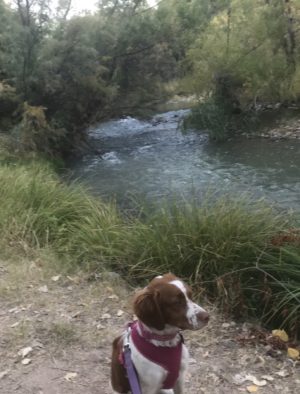
In our week of exploring the area, we made it back to Sedona (our third visit), the artsy town of Jerome, enjoyed fine Mexican food and great wine with Laurie and Clark Kerchen (I’d worked with Laurie in Lake County) in little-visited Cottonwood, took in Montezuma’s Castle and Well (misnamed locales that have nothing to do with Aztecs), all the while keeping our social distance, wearing masks when indoors, and generally loving our time in the high desert.
Of course, there were a couple of glitches. First, I couldn’t get the black water tank, the tank that holds the toilet proceeds, to empty. While I was working on that issue, I discovered water leaking from the faucet connections inside the bathroom vanity. I’d already tightened loose connections under the kitchen sink, experienced the water heater exploding hot water all over the exterior of the camper, and had nary a clue as to what the hell was going on. I tried and tried and tried to stem the flow of water dribbling down the hot and cold water hoses feeding the bathroom faucet but felt like Lucy in that episode with the chocolates on the conveyor belt: I’d stop one leak only to find another. My language was not something you can print in a family blog and my cursing awoke my wife and Callie.
“I’m going to the office to get laundry soap,” René said after she’d pulled on her clothes. “I’ll see if they can help.”
By then, I’d already called the Good Sam number, thinking that since I’d paid for 7 years of warranty protection, someone should offer instant assistance. After being put on hold, being given numbers to places that no longer offered RV or trailer service, and finally leaving my number on the answering machines of two repair shops, I wandered outside, cell phone in hand, fuming.
“I have a problem,” I said to John Benson, a pal from Proctor. John’s an ex-carpenter and a snowplow driver whose owned a motorhome for years. I figured he was my best bet. I started by explaining my black water problem.
“You got a hose? Not the one you use for fresh water, but one you use for cleaning?”
I did.
“Open up the valves and drop the hose down the toilet. Turn it on full. That should break things up.”
I was in the process of doing just that when René returned. She held out a brass fitting in her right hand to me.
“What’s that?”
She nodded towards the office. “Seems they have water pressure issues. They were supposed to tell us when we checked in but didn’t. This will regulate the pressure.” I accepted the device. After following John’s instructions and cleaning out the blockage in the sewer tank (I had to bring the hose in from the outside because I’d shut off the water to the trailer due to all the leaks), I dropped two tablets I’d bought in New Mexico down the toilet. A friendly guy we met in the hot tub, upon hearing about my potty woes, recommended putting in two tablets and letting things sit for two days before I tried to empty the black water again. That chore done, I hooked up the pressure regulator, reconnected the water and, viola, the leaks stopped. No more water gushing from the hot water heater either. We were lucky. Turns out, whenever you hook up to city water, you should have a pressure regulator in place. And, in another hot tub discussion, we learned you should also have a surge protector on your electrical hook-up to prevent a surge from frying every appliance in the place. No one at Gander bothered to tell us about either necessity and, given that Forest River (they own Puma) doesn’t believe is supplying a manual with their campers, you are pretty much on your own when it comes to discovering such maladies. The backed up poop? By the time we were ready to leave Camp Verde and tow the camper to Prescott, the pellets had worked their magic.
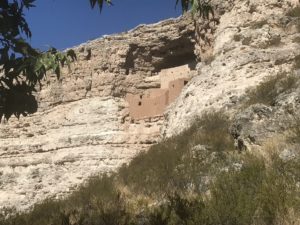
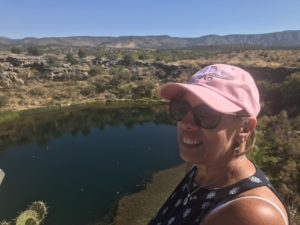
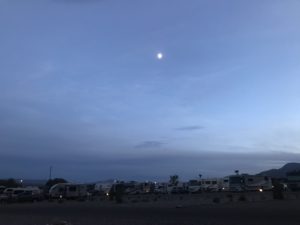
We scouted out the RV storage facility the day before we were scheduled to leave. Of course, the Jeep’s GPS sent us on a wild goose chase by asserting the road we were seeking was a through highway when it wasn’t. In the end, we found the place, checked it out, and the next morning, I used a bike tire pump to blow out the water lines after opening the low-point valves to drain the system. Try as I might, I couldn’t get a wrench on the hot water tank’s plug (which doubles, as I said, as the element). My sockets were too small so I figured I’d pick up a socket set in Prescott and drain the water heater at the storage lot. Right. Long story short. Two trips into town for sockets and I never did find one that fit. I tried, using the bike pump, to blow the water out the tank’s pressure release valve but, unconvinced I’d got it all, I hit upon a plan.
“Mike will be here next week,” I told René after exhausting my patience and my endurance. Mike Town and his wife Jill rent a place just up the road, one of the reasons we’d picked the Prescott/Verde area to vacation. I knew I could count on Mike to take care of draining the water heater.
In addition to that issue, my lovely wife and I were trying to put the new canvas cover on the camper in a forty-mile an hour gale. We got it done but our marriage barely survived. Instead of a half-hour project, we spent three hours messing around with the water heater and the cover. “I’ll call Mike once I figure out the right size socket he’ll need,” I said as I closed up the Puma, climbed into the Jeep, and we headed east.
An internet search revealed the socket was an odd size: 1 and 1/16ths inch, a size only a mechanic has in his or her toolbox. I texted Mike. He said he’d take care of things.
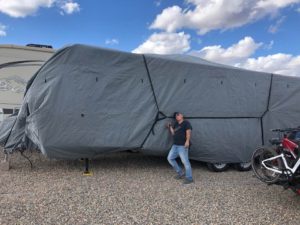
Compared to the travails experienced trying to winterize the camper, our trip home (despite a blizzard hitting Arizona, New Mexico and all points north) was uneventful except for discovering a slow leak in the Jeep’s rear passenger tire. We stayed at the Drury Suites in Santa Fe (highly recommended) and at a Best Western in downtown KC (modest by comparison) before making it home in one piece.
Mike and his brother in law drained the water heater a week after we left so I suspect René’s Big Ass Trailer is resting comfortably. I can only hope the Puma is still in one piece when we return in March.
Peace
The Weary Traveler



You did well Mark. Your maiden voyage could have been much worse. You were able to see some beautiful country. Hang in there things only get easier from here.
Enjoy your retirement and your travels.
True enough. Headed back in March.